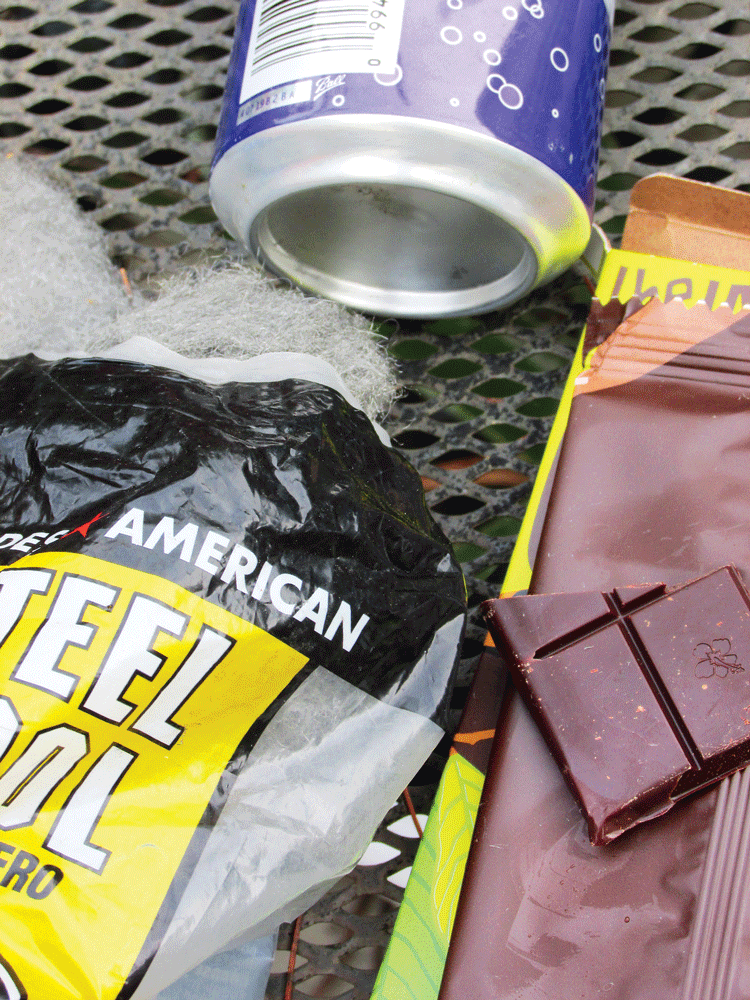MAKING A FIRE WITH AN ALUMINUM CAN
Fire-making is one of the most basic survival skills. Once you realize the importance of fire, you make sure you carry devices with you at all times for making a fire. You should learn about the modern devices for fire starting. Since matches and butane lighters can be used up, and because any product can be lost, it is important to also learn the primitive methods of fire-starting.
These so-called primitive methods include any of the ways to make fire with whatever you can find in the woods. This includes the hand drill, the bow and drill, the plow, the thong and the saw. All of these should be practiced, and practiced often until you have mastered them.
There are countless variations on the four basic fire-starting methods: chemical reactions, electricity, friction, and focusing of sunlight to a point.
A DISCARDED CAN
I was a bit skeptical when I first heard about a new method of fire-making using the bottom of an aluminum beer or soda can, but it actually works. Well, it works if you prepare the can properly, and if you have a lot of patience. The very bottom of an aluminum can is not a true parabolic dish, but when highly polished, it can be used to focus the sun’s rays to a point and ignite tinder.
POLISHING THE BOTTOM
Because the surface of the bottom of the aluminum can is not polished, you need to give it a high polish in order for it to sufficiently focus the sun’s rays.
Each time I had heard this method mentioned the suggestion was to do the polishing with chocolate. Yes, a bar of Hershey’s or whatever else you have. But why chocolate? To date, I have never received a satisfactory answer to this question and the only reason I believe it was ever suggested is because a backpacker might have chocolate in the pack. But they might also have toothpaste, which is a far better polishing agent than any chocolate I have tried. It’s always good to know several ways to do each task, but the easiest and best polishing medium I’ve found is fine steel wool.
“WITH PRACTICE, AND THE RIGHT POLISHING MEDIUM, YOU’LL HAVE ANOTHER FIRE-STARTING METHOD THAT COULD ONE DAY SAVE YOUR LIFE.”
Polish the bottom of the can for about 15 to 20 minutes, until you have an obviously-bright and highly reflective surface. Once the bottom of the can has the high polish, you are ready to make fire.

How do you know you are done? You test it, and see how well you can make a fire. Artist and experimenter Eric Zammit of Altadena discovered by practice that he could quickly get a coal if he had polished the bottom of the can with the finest steel wool [0000] for about 10 minutes. Then, using a small bit of rolled-up mugwort, he would have it smoking within three seconds and he had a coal within 10 seconds.
GOOD TINDER
Collect your tinder and roll it into the size of a cigarette. In fact, a cigarette would make good tinder. I prefer a rolled-up piece of dried mugwort, a common wild plant along waterways. Mugwort was used in the old days by Southern California Indians when they wanted to transport a coal or ember.

You can also use dried bark, various leaves, moss — anything that is dry and holds together well when rolled into a small shape.
Point the bottom of the can towards the sun, and then move your tinder into the bottom area, watching for the point where the light focusses to a point. When you find that point, keep your tinder there until you get your coal. This is akin to making a fire with a magnifying glass, except you are not focusing the light through the lens, but back up to a single point.
REAL-WORLD RESULTS

Eric Zammit found he could fairly easily ignite mugwort using this method, as long as the bottom of the can was highly polished and as long as it was close to midday when the sun was directly overhead.. He could not ignite paper, though he was able to ignite leaves. Zammit had the best results by holding the can in his hands, and propping his elbows on his knees. Then he aligned the can with the sun by watching the can’s shadow until the shadow corresponded with the diameter of the can, but no larger.
“By holding the can at eye level, I could look under the mugwort to find the focal point of the light, and to put it right on the tip of the mugwort,” says Zammit.

With practice, and the right polishing medium, you’ll have another firestarting method that could one day save your life.
“Wow — this is cool, it really works! I was amazed at how fast this produced a coal,” said Zammit. I have since taught this to my students as an “emergency” method for making fire, when you have absolutely nothing else for fire-making. This is not one of the best non-match ways to make a fire, and it is not my favorite, but it will make a coal and fire nevertheless. One of the teaching assistants in my classes, Gary Gonzales, has gotten a coal in seconds with this method, but he admits that the bottom of the can must be highly polished. It has taken him as long as 20 minutes to get a fire this way. So, the possibilities are endless with this simple and easy method.
Editors Note: A version of this article first appeared in the March 2015 print issue of American Survival Guide.


